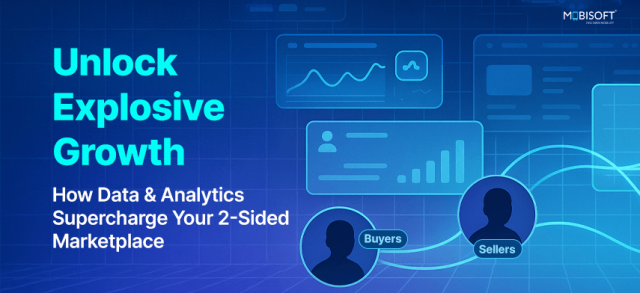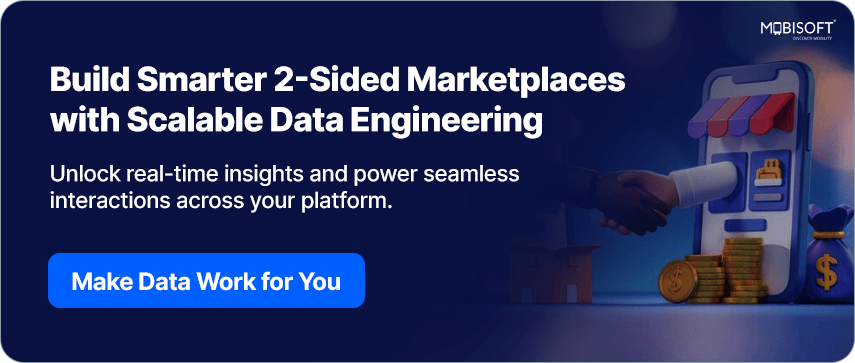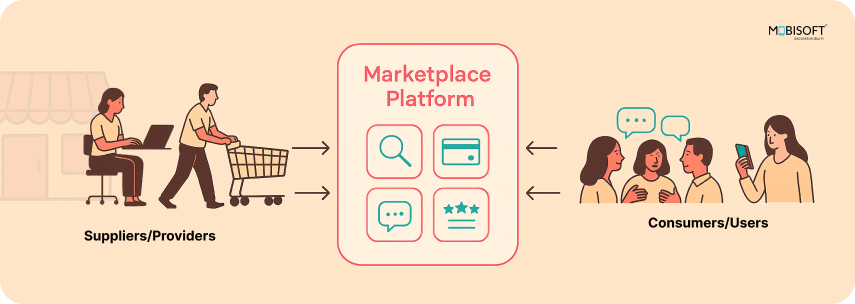Data & Analytics to Grow Your 2-Sided Marketplace Fast
Data & Analytics to Grow Your 2-Sided Marketplace Fast

In online marketplace platforms, data analytics and user behavior analytics are the Holy Grail, providing companies with insights that can inform decisions and drive marketing, improve customer experiences, and grow their businesses through data-driven marketplace optimization.
Leveraging Data Enables Businesses To:
- Understand Customer Behavior – Understand user behavior and purchasing habits.
- Optimize Marketing – Monitor and enhance campaign performance.
- Identify Market Trends – Discover new opportunities and shifts in advance.
- Enhance Customer Experience – Personalized messaging and offers.
- Drive Growth – Make strategic decisions for long-term success.
Understanding Two-Sided Marketplaces and Their Unique Challenges
A 2-sided marketplace platform is one that brings two different sets of users, often consumers and service providers, together and enables them to interact and exchange with one another.
These are platforms like Uber, where service providers, drivers, provide rides to passengers, the consumers. There is also Airbnb, where service providers, hosts, lease their buildings to guests, the consumers.
Some common categories of marketplace platforms include:
- Hiring websites like Indeed/Naukri help with union of employers and candidates.
- Freelance platforms such as Upwork connect companies and freelancers.
- Ride-sharing companies such as Uber link riders and drivers.
Most two-sided marketplaces make money by levying a commission to facilitate transactions between consumers and service providers. Consider, for instance, all the various Zomato service fees that are added to your $15 pizza delivery. Some marketplaces, such as Naukri, make money by charging one side, i.e., the employers, and making the other, job seekers, free.

Harnessing Data to Power Two-Sided Marketplaces
In 2-sided markets, data analytics has a driving impact on keeping supply and demand in balance, delivering continuous improvement in user experience, and enabling sustainable growth. Utilizing knowledge of user behavior analytics, transaction patterns, and predictive analytics in marketplaces, platforms can improve personalization, anticipate demand, and optimize pricing dynamically.
Let's further explore this blog on building transaction analytics platforms and creating data analytics marketplaces. Companies can develop data-driven business models (DDBMs) to identify value and solidify strategic partnerships through robust data engineering services.
While data is a powerful enabler, platforms also have to overcome some very severe challenges, including managing supply and demand, guaranteeing quality, avoiding platform leakage, and beating their competitors.
Key Components of a 2-Sided Marketplace Platform

2-sided platforms have some elements in common. Let's examine the anatomy of a two-sided marketplace and the core components that make it happen.
The primary user groups: Consumer & Service Providers
At the heart of any thriving marketplace, online or offline, are the two primary user groups: the consumers and the service providers. These people generate almost all the activity on the platform, engaging in a continuous dance of supply and demand.
Consumer
These are users in search of a particular product or service. They come to the marketplace platform for the convenience, the options, and the competitive prices.
But it's not just about scoring a sweet deal. Consumers also enjoy a sense of trust and security that comes with purchasing through an established data-driven marketplace. For instance, protection policies help ease any worries.
Platforms cater to this by simplifying purchasing with consumer tools like:
- Search filters to quickly discover listings.
- Sorting to view products by price, ratings, etc.
- Secure payment processing.
- Review systems to identify quality service providers.
- Protection/refund policies.
Generally, users have to register accounts and provide a little bit of information: name, payment details, etc. Other marketplaces might also ask for the shipping address or the preferred method of communication.
Service Providers
The platforms themselves are service providers. These could be individual vendors, or they could be corporations looking to advertise and sell their merchandise to wider audiences.
Service providers typically must provide account information and details about the type of business they operate, the goods or services they provide, and payment information, just as consumers do. They also potentially have convenient tools to manage listings, speak to customers, and manage sales using insights from marketplace analytics.
Key features for service providers include:
- Self-service dashboards to manage listings, inventory, and orders.
- Promotional tools, like coupons, to boost sales.
- Communication channels to interact with customers.
Reporting to gain insights into product performance using marketplace data insights.

The role of the platform in facilitating interactions
At the heart of any two-sided market lies the platform. It facilitates the meeting of consumers and service providers. It creates value in the sense that it provides the means and the trust to facilitate significant transactions, an essential part of any two-sided marketplace strategy.
Key responsibilities include:
- Marketing Tools – Helping service providers reach the right consumers through targeted promotions.
- Payment Processing – Managing secure, streamlined transactions with purchase protection.
- Trust & Safety – Establishing trust based on features such as authenticated profiles, user ratings, and open policies.
- Dispute Resolution – Helping both sides by resolving disputes timely and fairly.
In short, the offers an end-to-end experience from discovery through post-sales support, and the order is kept in place by controls, governance, and rules.
The Role of Data Analytics in Optimizing 2-Sided Marketplaces
For an online marketplace platform where buyers and sellers meet, information determines growth, personalization, and performance. It also supports customer acquisition in marketplaces, builds trust, enables better pricing, and guides critical decisions.
Types of data relevant to 2-sided marketplaces
User behavior data (consumers and service providers):
Understanding how consumers and service providers interact with your platform is crucial. This includes:
- Clicks, scrolls, time spent on pages
- Product/service views
- Wishlist additions or “favorites”
- Response time (from service providers)
- Abandonment rates (for consumers)
Why it matters
Behavioral data powers personalization, simplifies onboarding, and helps identify friction points in the user experience, supporting better retention strategies marketplace-wide.
For implementation reference, you can explore the Google Analytics 4 (GA4) Guide to understand how to collect and analyze user behavior effectively.
Transaction data:
- Volume of completed transactions.
- Average order value (AOV).
- Conversion rates (visitor to consumer).
- Service provider performance metrics (fulfillment rate, cancellation rate).
- Refund and dispute rates.
Why it matters
Marketplace conversion rate analytics help fuel loyalty programs, detect anomalies, and improve operational efficiency.
Market trends and competitive analysis:
- External market data (e.g., pricing benchmarks, industry reports).
- Seasonality and demand shifts.
- Geographic behavior differences.
- Competitor pricing and offerings.
Why it matters
These insights are foundational for product strategy, price sensitivity analysis, and inventory control, as covered in E‑commerce Analytics: The Ultimate Guide to Growing Your Online Store.
Importance of Data Collection and Management.
An effectively governed marketplace platform is a data-driven engine. Let's see how the collection of structured data and effective data governance are important for driving growth in data analytics
- Personalization: Suggesting products or service providers based on behavior history.
- Trust & Safety: Fraud detection algorithms need quality, real-time data.
- Dynamic Pricing: Supply/demand-based pricing models improve margins.
- Growth Analytics: Understand which levers (marketing, referral, promotions) drive user acquisition and retention.
Feedback Loops: Structured reviews and ratings enrich decision-making for both sides.
- AI
- Vitamins
- Health
- Admin/office jobs
- News
- Art
- Causes
- Crafts
- Dance
- Drinks
- Film
- Fitness
- Food
- Spiele
- Gardening
- Health
- Startseite
- Literature
- Music
- Networking
- Andere
- Party
- Religion
- Shopping
- Sports
- Theater
- Wellness


